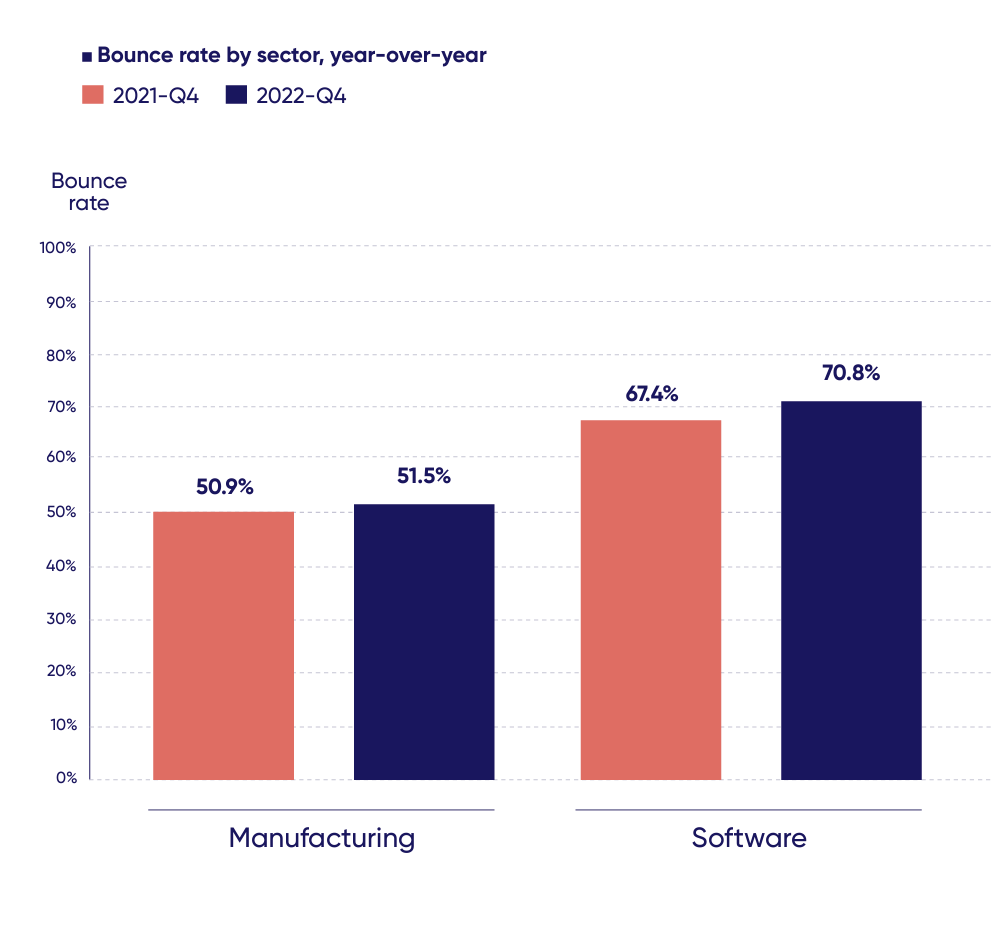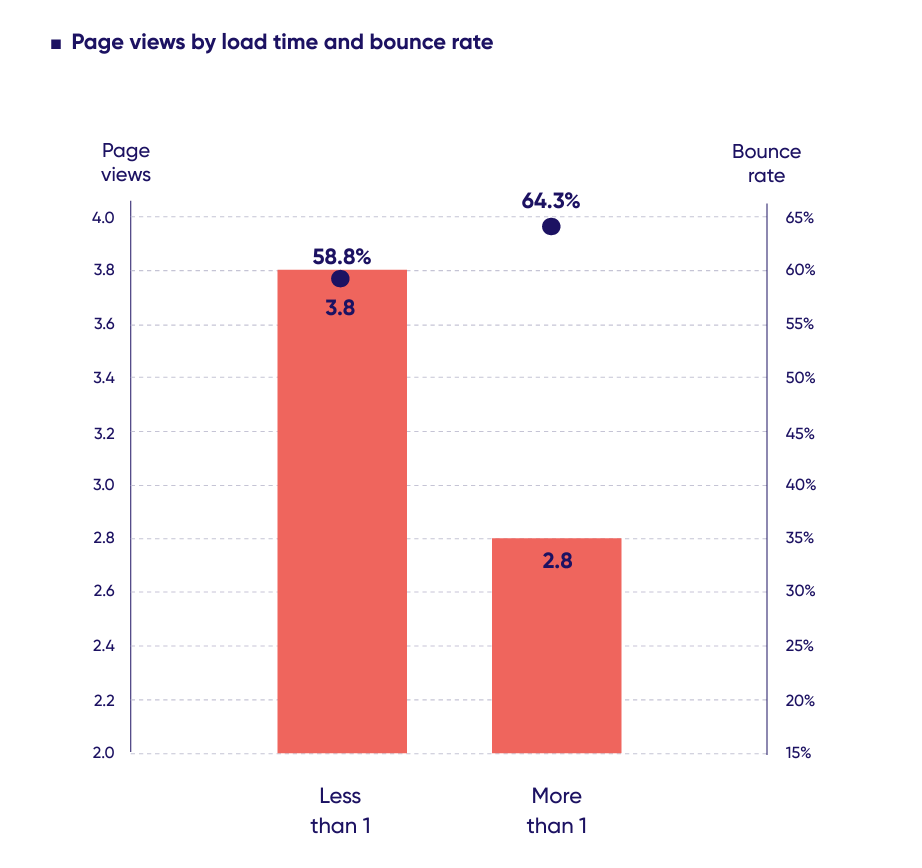
See how your digital experience stacks up.
Download the 2023 B2B Digital Experience Benchmark report.

Digital experience (DX) has become the key differentiator for B2B businesses in recent years—and the B2B digital customer journey a top priority.
B2B buyers today are increasingly millennials, and would rather discover new products through independent online research than in-person interactions.1
Little wonder, then, that B2B eCommerce took the lead as the most effective sales channel for B2B companies last year, ahead of in-person sales, video conference, email and telephone.2
With buyers spending more time on your website than with your sales teams, your digital customer experience has a big (and ever bigger) influence over your customer relationships and business growth.
Differentiating in this digital-led era is about meeting and exceeding the modern B2B buyer’s expectations for DX.
That requires you to understand the B2B buyer’s behavior, preferences and emotions: What frustrates them, what delights them, what converts them, and what keeps them coming back.
In this article, we’ll run you through three insights into B2B site visitors’ behavior that you’ll need to know to deliver the best B2B customer experience possible.
All three insights are from our 2023 B2B Digital Experience Benchmark report, which shares the trends that shaped B2B CX in 2022 and the strategies that should shape your B2B digital customer journey in 2023.
See how your digital experience stacks up. Download the 2023 B2B Digital Experience Benchmark report.
Digital teams at B2B companies need to know where things are going wrong in their journeys to improve them—and there are few (if any) website engagement metrics that can tell you that more surely than bounce rate.
Bouncing is usually the last thing you want a visitor to your site to do. On certain pages, a high bounce rate might be predictable, even acceptable. But it’s never ideal.
So how effectively did B2B sites minimize bounces in 2022?
First, the good news: B2B site bounce rates were cut by 1.5% year-over-year. That’s a small but significant move in the right direction.
Now the bad news (you knew it was coming, right?): B2B still has a long, long way to go when it comes to cutting bounce rates.
Even with the year-over-year reduction, the average bounce rate for B2B sites was 61.1%. That means three out of five visitors to B2B sites bounced.
And the news is even worse if you’re a software business: Software sites had an average bounce rate of (brace yourself) 70.8%.
That’s… Well, it’s not good. In fact, it’s one of the highest bounce rates in any of the nine industries we analyzed in putting together the cross-industry 2023 Digital Experience Benchmark report.

To find out how bounce rates differed according to sector, device and page type, you’ll need to read our Benchmark report—in which we also share tips and strategies for preventing bounces.
But first, read on for two insights from the report that point the way for B2B companies looking for an excellent place to start.
One major cause of bounces is user frustration, which was worryingly common in B2B site sessions last year, impacting almost 1 in 3 (30.2%).
One way B2B brands can reduce user frustration is by speeding up their sites. The leading cause of frustration (topping the list of five frustration factors in our report) was slow page loads, which negatively impacted 18% of B2B sessions.
What’s more, our data shows that load time is directly linked to bounce rate, with sites that loaded in less than a second seeing -9.4% fewer bounces than those that took over a second to load. (Speedy sites also earned an entire extra page view per session.)
No doubt about it: A speed analysis tool should be part of every B2B business’s digital kit in 2023.

Our report also reveals another proven way to prevent bounces (and increase site engagement overall): Encouraging user activity.
User activity measures the amount that site users are interacting with a site—what percentage of time they spend on sites clicking, scrolling, swiping and typing.
Compared to sites that provoke lower levels of activity from users, sites with higher levels of user activity reap significant rewards: A -24.5% reduction in bounce rate and +41 deeper sessions. (‘Deeper’ meaning more pages viewed across the whole session.)
For insights into how active visitors are per B2B sub-industry, which page types see the most activity and how to encourage user activity in your B2B digital customer journey (plus a deeper look into page load times), you know where to look…
B2B buyers typically browse for products during their workday, while sitting at their desks. That’s why desktop has traditionally dominated traffic to B2B sites.
But while desktop accounted for 64.3% (over two-thirds) of B2B site traffic in 2022, this was a -7.5% drop from 2021. Mobile traffic was up +4.8% percentage points.
Moreover, mobile traffic had a bigger share of new visitor traffic in 2022, up from 43.5% to 46.7%.
While manufacturing sites still attract a majority of new visits from desktop (61.3% in 2022, a 2.4 percentage point increase from 2021), mobile drove a comfortable majority of new visits to software sites last year: 68.1%.

These stats show the difference in intent between desktop and mobile browsers, as does the fact that mobile users spent 36.7% less time per session than desktop users on B2B sites last year.
Mobile is great for quickly checking out sites, but desktop is simply more convenient when it comes to deeper exploration.
However, with more and more first impressions being made on mobile (particularly in Software), B2B businesses would be well advised to optimize their mobile experiences for new visitors—and ensure they integrate these experiences seamlessly with the desktop experience.
In this article, we’ve given you a sneak preview of the insights in our Benchmark report—and there are plenty more where that came from.
How did we get all these insights? By applying the most powerful lens that can be applied to the digital experience: Contentsquare’s own Digital Experience Analytics (DXP) platform.
Check out this short product demo to see how platform features and products like Customer Journey Mapping, Zone-Based Heatmaps, Session Replay will help you remove friction and add delight to your B2B digital customer journeys.
Take a product tour Get to grips with Contentsquare fundamentals with this 6 minute product tour.